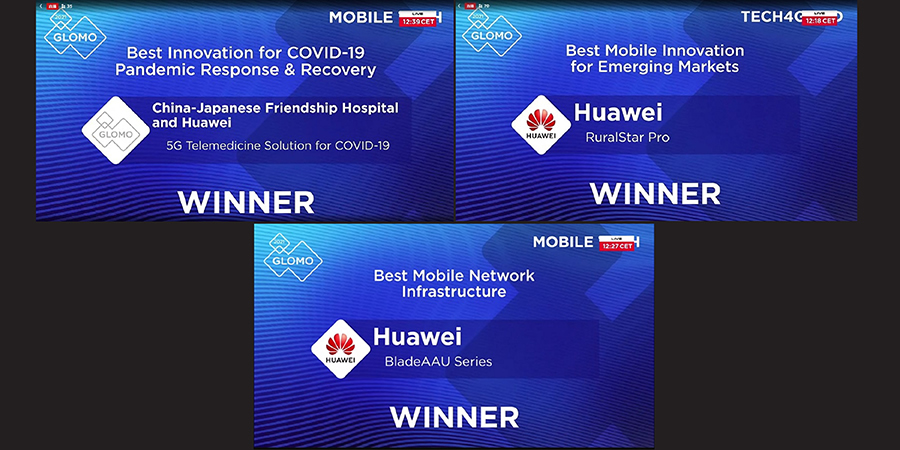At the 2021 Mobile World Congress (MWC 2021) in Barcelona, the Global System for Mobile Communications Association (GSMA) announced the winners of the 2021 Global Mobile (GLOMO) Awards. Huawei was the recipient of 3 awards, namely the “Best Mobile Network Infrastructure”, “Best Mobile Innovation for Emerging Markets” and “Best Innovation for COVID-19 Pandemic Response & Recovery”.
Best Mobile Network Infrastructure
Huawei's BladeAAU series took home the 'Best Mobile Network Infrastructure' award, confirming the industry's recognition of Huawei's customer-driven innovation in helping operators build high-quality mobile network infrastructure with breakthrough products in the 5G era.
Huawei launched the industry's first BladeAAU product in 2019 to help operators overcome deployment challenges relating to the insufficient antenna space. By integrating a Massive MIMO AAU with a multi-band passive antenna into a single box, this product enables all sub-6 GHz bands to be deployed within the most compact dimensions the industry has ever seen, greatly easing the difficulties of network deployment. By interworking with Huawei's SingleRAN technology, BladeAAU has enabled the implementation of Massive MIMO in single-pole scenarios.
In 2020, the BladeAAU series continued to evolve with a brand-new product — BladeAAU Pro. This new solution is the first in the industry to support 64 channels with integrated active and passive modules. It also supports a maximum transmit power of 320 W and further upgrades passive antenna port specifications to empower transition to all-band deployment over the next 10 years. Its dimensions are further reduced, adding extra flexibility for adapting to various scenarios. Since its initial launch, it has become the preferred choice for global operators targeting network construction in single-pole scenarios, and has been put into commercial use worldwide, helping operators in countries such as China, Switzerland, France, Finland, and Ireland to quickly roll out 5G services.
The Judges had this to say about the Huawei for BladeAAU series: “This stands out as a vital enabler for operators deploying 5G, ensuring support for commercially important spectrum in the years to come in a single form factor that reduces CAPEX and OPEX costs. Widescale global deployment of the product in more than thirty networks provides evidence of market momentum and broad positive impact on 5G deployment.”
Best Mobile Innovation for Emerging Markets
Huawei RuralStar Pro solution took home the "Best Mobile Innovation in Emerging Markets" award of GSMA GLOMO, confirming that Huawei's contribution to the digital lives of those in emerging markets is highly recognized by the industry.
In 2021, Huawei launched the industry's first integrated access and backhaul solution — RuralStar Pro — achieving the highest integration (RF/baseband/backhaul integration) and effectively replacing traditional costly transmission modes of optical fiber, microwave, and satellite. In addition, Huawei's smart PV solution has achieved pure green energy (no mains or no diesel generator).
Thousands of RuralStar base stations have been deployed worldwide to provide MBB and voice services, bridging the digital divide for rural areas. Amid the COVID-19 pandemic, network coverage in remote areas ensured that online classes were available to all students in all villages, and that latest news and relief information was circulated to facilitate medical services in rural clinics, effectively avoiding large-scale transmission of the virus. In addition, farmers have access to the latest information about the produce market, and can lift themselves out of poverty through online sales.
David Guo, President of Huawei Wireless Network Site Product Line, said, "To date, Huawei RuralStar family solutions have been commercially deployed at over 20,000 sites in more than 60 countries across Asia, Africa, Latin America, and Middle East. RuralStar Pro is the latest product of Huawei's continuous investment in this field, which extends over many years. It features high integration, fast deployment, and easy maintenance, and will accelerate the popularization of rural network coverage and bring digital life to every corner of the world."
Best Innovation for COVID-19 Pandemic Response & Recovery
The telemedicine solution for COVID-19 developed by the China-Japan Friendship Hospital based on Huawei's 5G network solutions was awarded GSMA GLOMO 'Best Innovation for COVID-19 Pandemic Response & Recovery'.
The China-Japan Friendship Hospital has been leveraging 5G to improve patient services and bring digital remote auscultation to various ICU wards and primary hospitals, while assisting more than 5,000 hospitals across China through remote healthcare. Its 5G remote consultation system has been used by many hospitals to conduct remote consultations, CT examinations, and type-B ultrasounds, helping them treat COVID-19 patients efficiently. These 5G smart healthcare applications were developed together with Huawei, and have played a key role in fighting the pandemic.
Marvin Chen, President of Huawei DIS Product Line, said: “5G is seeing large-scale application in healthcare. More than 700 hospitals in China have deployed 5G and have started to undertake pilot projects, or apply it commercially. By equipping existing devices with 5G modules and integrating 5G modules into new equipment, a plethora of 5G services have been explored in a growing number of hospitals. Huawei will continue to innovate 5G solutions together with the healthcare industry to develop 5G applications that can help fight the pandemic and get more value out of 5G."
The annual GLOMO Awards were set up to recognize pioneering feats of mobile technology. Prizes are handed out in a variety of different categories, including Mobile Technology, Connected Consumer, Industry X, and Tech4Good. More than 250 independent judges from across the world are involved in the award process. The panels comprise leading industry experts, analysts, journalists, academics and in some cases representatives from mobile operators.










